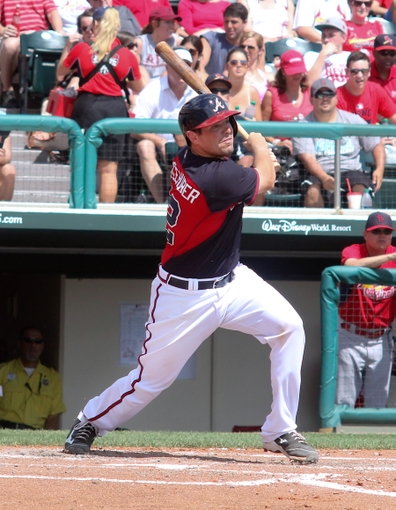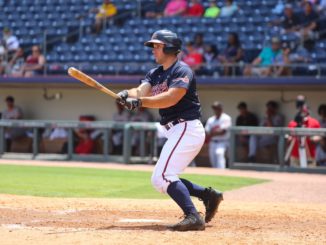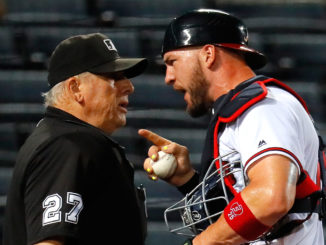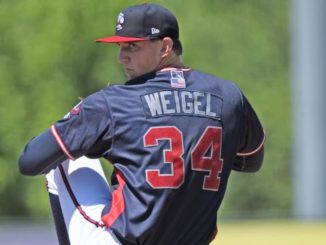
11/12/16 – Braves sign C/1B David Freitas to a minor league contract.
Freitas, who’ll be 28 by the time he plays for a Braves affiliate, was a 2010 15th round pick by the Nationals. He hit pretty well upon his introduction to the minors, and he built enough value to get traded for a big leaguer, with Washington sending him to Oakland for Kurt Suzuki. In his first full year in the A’s system, he didn’t rake quite like he did with the Nats, and Oakland traded him to Baltimore as part of a package for Jim Johnson. The Cubs later claimed him on waivers, and that’s where he spent 2016, where he rediscovered his stroke, slashing .286/.344/.423 in AA and .321/.362/.476 in AAA.
Guys who figure out how to hit AAA pitching when they’re 27 don’t usually become stars, but there’s a chance he could hit enough to justify being a step away from Atlanta. In the event of a Tyler Flowers injury, Freitas could maybe replace Flowers in the batting order and not completely embarrass himself. I could see a .225/.300/.375 guy at the MLB level, with enough pop to hit 10-15 HR. Not good, but not useless in the event he’s needed.
He could also, most likely, replace Flowers on the defensive side as well. Minor league metrics paint Freitas as a good pitch framer and blocker. While he doesn’t scare runners on the basepaths, he’s a competent enough thrower from behind the plate. All in all, it’s a nice depth signing. Freitas appears to be a perfect “break glass in case of emergency” type of player to be an understudy to Tyler Flowers.
11/13/16 – Braves sign C Braeden Schlehuber to a minor league contract.
Schlehuber’s was one of the first player pages I wrote, so I glanced at it to see if it needed to be updated to reflect any new data gathered in the 2016 season. Nope. The good defensive profile is still there, and it’s still unlikely to matter at the MLB level due to the offense. The glove should keep him around the high minors for a few years and earn him some spring training invites, though. Pitch framing would seem to have significant psychological value in the minors. Stealing some borderline calls should give young prospect arms confidence and help their progression. Schlehuber can do just that in his age-29 season in 2017. And, because every team needs a bunch of spring training catchers, he can spend time in March catching big leaguers and top prospects. There are worse ways to spend a month.
11/14/16 – Braves sign UT Colin Walsh to a minor league contract.
The baby of this trio, Walsh will be 27 next season. He started in the Cardinals system, where in 2012 he slashed .314/.419/.530 as a 22 year old in low-A ball. His offense flatlined when he reached AA, so the Cardinals released him. He was picked up by Oakland, and in 2015, Walsh finally conquered AA, batting .302/.447/.470. He struck out over 20% of the time and walked over 20% of the time. The guy was a pitch-eater, more or less. That was enough for the Brewers to take a shot on him in the Rule V draft, and he started 2016 with the MLB team (per Rule V rules). He assembled a pretty unique slash line in the majors over 63 plate appearances: .085/.317/.106. He drew the walks, as you can see, but swinging the bat proved to be disastrous in nearly every instance. The Brewers couldn’t take any more and sent him back to Oakland, where he finished the year in AAA. Walsh already holds a weird distinction. He has the most career MLB plate appearances for any position player whose OBP is at least 3 times his BA.
He’s an unusual player. He can play 2nd or 3rd, and fill in around the corners of the OF as well. And the pitch-eating is tantalizing. Even at the MLB level, where pitchers had little to fear, his at-bats lasted an average of 4.61 pitches. Unfortunately, as MLB shifts away from needing SP to go deep into games, a skill set like Walsh’s becomes less useful. Walsh taking 5 to 7 pitches before he inevitably strikes out or hits a routine grounder would be an irritating at-bat for a pitcher trying to go 8 or 9 innings. For a pitcher shooting for 6? Not as much. For Walsh to be useful at the MLB level, he’ll need to either find a way to hit the ball with more authority or hope that MLB changes its current trends. Neither is a probability, but it doesn’t stop Walsh from being an interesting player to have in the system.




Leave a Reply